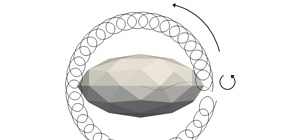
Bacterial flagellar motion consisting of spin and revolution
Physical principles behind this new top-like motion clarified
A group of researchers from Osaka University and Tohoku University found that bacterial flagella show the filament motion consisted of two types of rotation: spin and revolution in experiments. They also clarified that such rotation is explained by flow generated by bacterial flagella.
- Frontier Research Institute for Interdisciplinary Sciences, Tohoku University -- Yuji Shimogonya (Assistant Professor)
- School of Engineering, Tohoku University -- Takuji Ishikawa (Professor)
- Graduate School of Frontier Biosciences, Osaka University -- Akihiko Ishijima (Professor)
- Institute of Multidisciplinary Research for Advance Materials, Tohoku University -- Yuichi Inoue (Professor)
- Graduate School of Life Sciences, Tohoku University -- Yoichiro Sawano (Student), Hiromichi Wakebe (Student)
Experimentally observing that bacterial flagella had a filament motion consisting of two types of rotation, spin and revolution, this group tried to model and formulate the rotation of flagella.
Using a model for showing that the part connecting a flagellar motor with a flagellum (called a ‘hook’) acts as a kind of universal joint, this group examined flagellar behavior in water. As a result, this group succeeded in reproducing characteristic rotation, spin and revolution, observed in experiment.
Next, using hydrokinetic theory, this group formulated the relationship between the motor torque contributing to spin and revolution, respectively, viscosity resistance, and rotational velocity. The rotational velocity calculated from this theoretical formula, in both spin and revolution, corresponded with analysis results obtained from numerical computation, which verified the theoretical formula.
Furthermore, this group compared the result predicted from their theoretical formula with experimental results. As a result, regarding the relationship between the turning radius and the rotational velocity of the flagellum, the theoretical prediction corresponded with experimental results. Moreover, by applying their theoretical formula to these experimental results, they estimated the torque generated by flagellum, which is difficult to measure in experiment under present circumstances, showing the usefulness of their theoretical formula.
This group’s achievement sheds light on physical principles behind bacterial flagellar motion and it is expected that it will become an important step toward the understanding and control of a bacterial flagellar motor.
Abstract
The bacterial flagellar motor is an ion-driven rotary machine in the cell envelope of bacteria. Using a gold nanoparticle as a probe, we observed the precession of flagella during rotation. Since the mechanism of flagella precession was unknown, we investigated it using a combination of full simulations, theory, and experiments. The results show that the mechanism can be well explained by fluid mechanics. The validity of our theory was confirmed by our full simulation, which was utilized to predict both the filament tilt angle and motor torque from experimental flagellar precession data. The knowledge obtained is important in understanding mechanical properties of the bacterial motor and hook.

Figure 1

Figure 2
To learn more about this research, please view the full research report entitled " Torque-induced precession of bacterial flagella " at this page of the Scientific Reports website.
Related link

